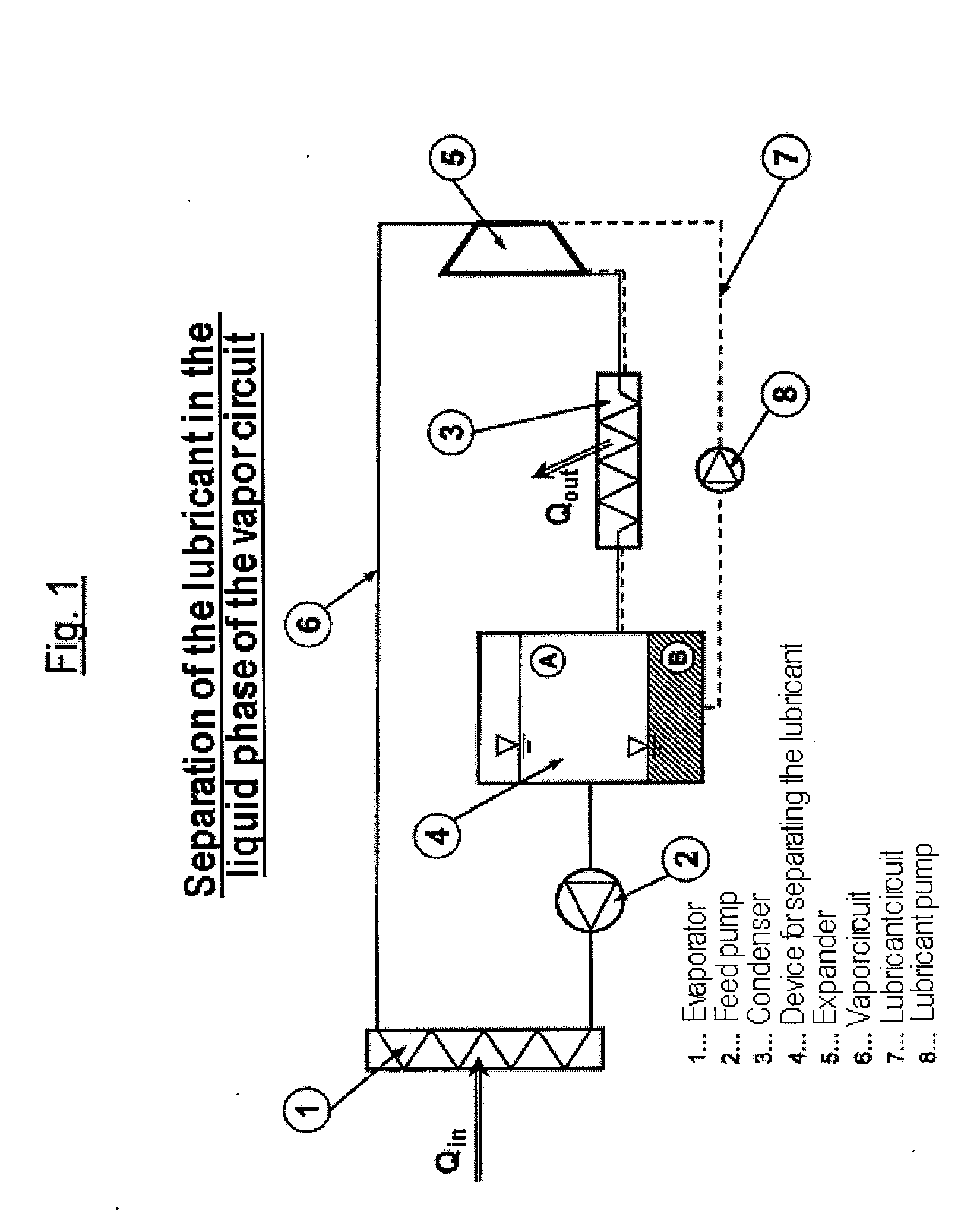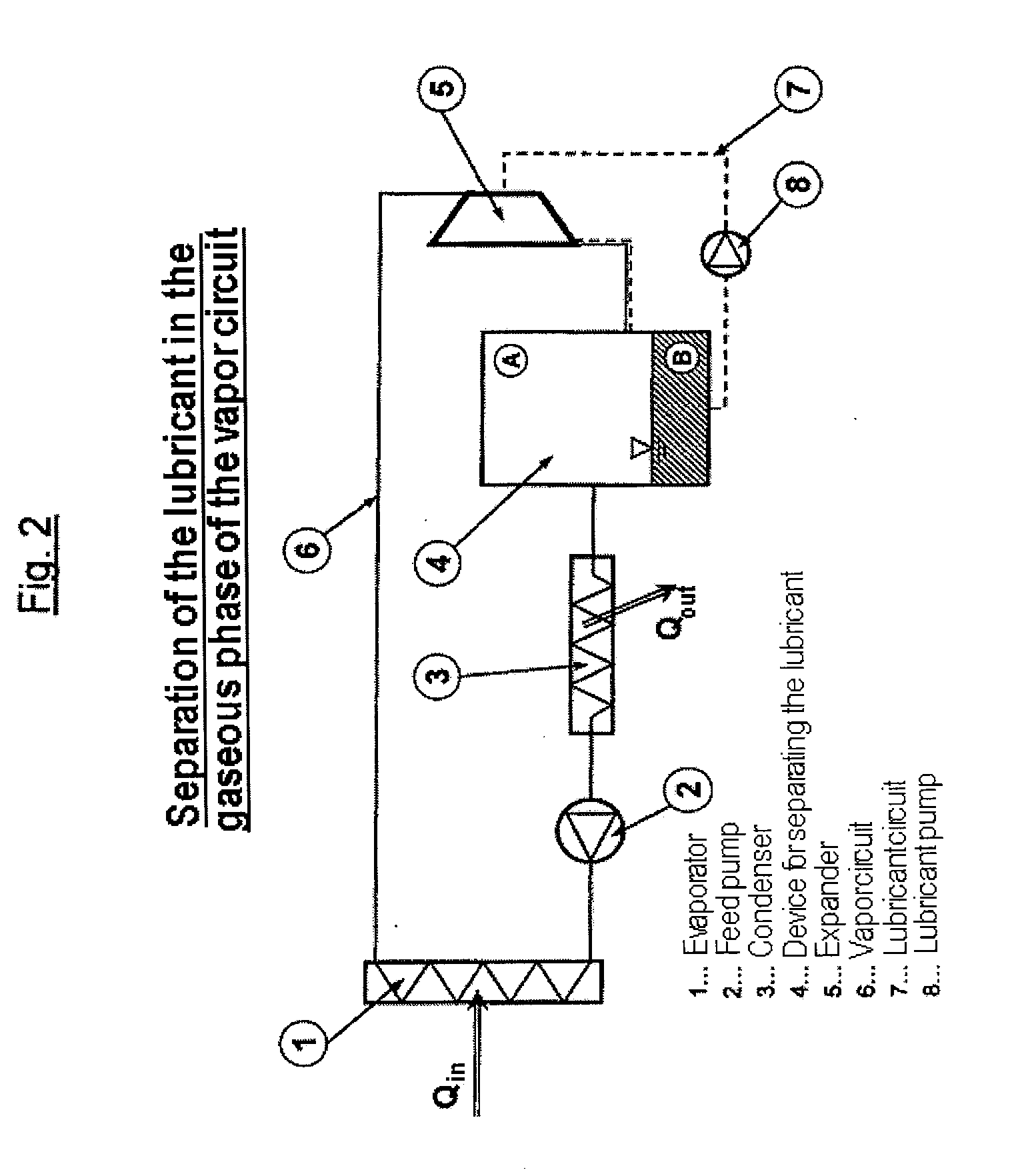Method and Apparatus for Operating a Steam Cycle Process with a Lubricated Expander
a technology of lubricating expander and steam cycle process, which is applied in the direction of steam engine plants, lubricant compositions, machines/engines, etc., can solve the problems of premature aging, chemical conversion, and contamination of the components and working media with decomposition products of lubricant, and achieve the effect of effective separation of lubricating oil and economic operation of the cycle process over a long period of tim
- Summary
- Abstract
- Description
- Claims
- Application Information
AI Technical Summary
Benefits of technology
Problems solved by technology
Method used
Image
Examples
experiment 1
[0078]Case A: Separation by Gravity
[0079]50 g of 1-ethyl-3-methylimidazolium ethyl sulfate (ionic liquid) were stirred vigorously with 50 g of 1,1,3,3-tetramethyl disiloxane (vapor-generating working medium) in a closed round-bottomed flask for 2 hours by means of a magnetic stirrer and in a heating bath at a temperature of 80° C., which is a typical application temperature. The mixture was transferred into a shaking funnel and shaken very vigorously by hand for one minute. After the end of the shaking process, it was observed that a clean phase separation took place within a few seconds. After a waiting time of 2 minutes, which is a typical standing time for a phase separation by gravity in the typical application, the two phases were separated and poured, for measurement, into sample bottles.
[0080]Case B: Separation by Filtration
[0081]The process described above with respect to Case A was repeated with a second sample, wherein in addition to the separation by gravity, the separate...
experiment 2
[0087]50 g of 1-ethyl-3-methylimidazolium ethyl sulfate (ionic liquid) were stirred vigorously with 50 g of hexamethyl disiloxane (vapor-generating working medium) in a closed round-bottomed flask for 2 hours by means of a magnetic stirrer and in a heat bath at a temperature of 80° C. (typical application temperature). The mixture was transferred into a shaking funnel and was shaken very vigorously by hand for 1 minute. After the end of the shaking process, it was observed that a clean phase separation took place within a few seconds. The rest of the experimental procedure took place as in Experiment 1, described above. The linear regression of the calibration curve R2 was better than 0.95.
Results:
[0088]Concentration of the 1-ethyl-3-methylimidazolium Ethyl Sulfate in Hexamethyl Disiloxane
Case A (separation by gravity): 350 ppm
Case B (separation by centrifuging): 55 ppm
Case C (separation by centrifuging and filtration): 26 ppm
Estimation of the Remaining Working Medium in the Ionic L...
experiment 3
[0090]50 g of 1-ethyl-3-methylimidazolium methane sulfonate (ionic liquid) were stirred vigorously with 50 g of 1,1,3,3-tetramethyl disiloxane (vapor-generating working medium) in a closed round-bottomed flask for 2 hours by means of a magnetic stirrer and in a heat bath at a temperature of 80° C. (typical application temperature). The mixture was transferred into a shaking funnel and was shaken very vigorously by hand for 1 minute. After the end of the shaking process, it was observed that a clean phase separation took place within a few seconds. The rest of the experimental procedure took place analogously to Case C in Experiment 1, described above. The linear regression of the calibration curve R2 was better than 0.95.
Results:
[0091]Concentration of the 1-ethyl-3-methylimidazolium Methane Sulfonate in 1,1,3,3-tetramethyl Disiloxane
Case C (separation by centrifuging and filtration): 23 ppm
Estimation of the Remaining Working Medium in the Ionic Liquid:
[0092]The working medium 1,1,3,...
PUM
 Login to View More
Login to View More Abstract
Description
Claims
Application Information
 Login to View More
Login to View More - R&D
- Intellectual Property
- Life Sciences
- Materials
- Tech Scout
- Unparalleled Data Quality
- Higher Quality Content
- 60% Fewer Hallucinations
Browse by: Latest US Patents, China's latest patents, Technical Efficacy Thesaurus, Application Domain, Technology Topic, Popular Technical Reports.
© 2025 PatSnap. All rights reserved.Legal|Privacy policy|Modern Slavery Act Transparency Statement|Sitemap|About US| Contact US: help@patsnap.com



